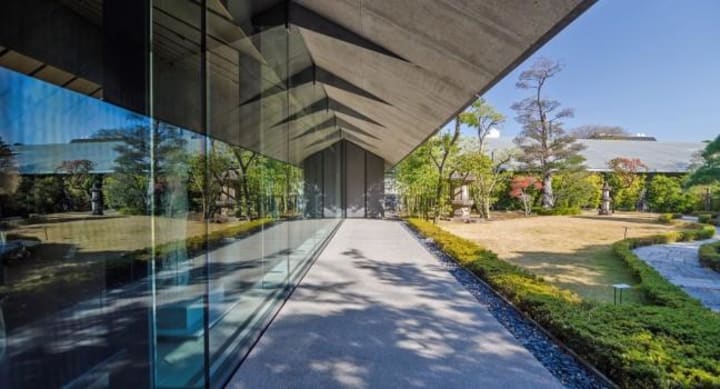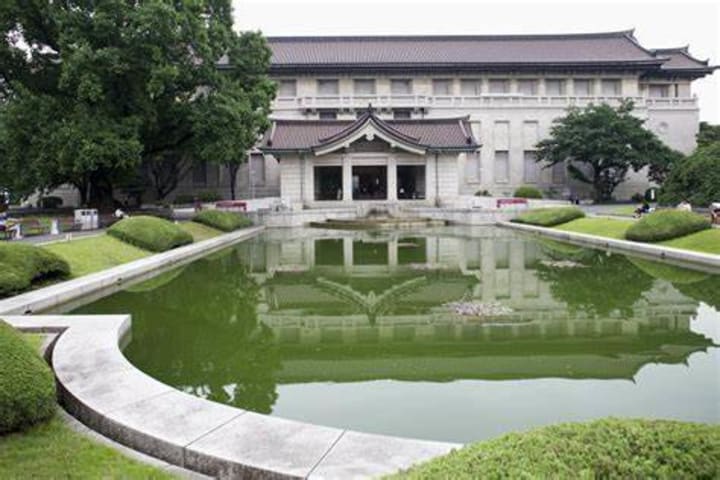Tokyo on the Sumida River
The capital of Japan

Tokyo is a capital that is a mix of modern architecture and tradition. There are skyscrapers rising high into the sky and wonderful temples. There are many things to delight in and places to explore and beautiful gardens where you can relax and enjoy nature.

Tokyo’s seat of power the Metropolitan Government Building was designed by Tange Kenzo and completed in 1991. Visitors can take an elevator to one of the twin 202 meter high observatories both of which offer panoramic views over the city. On a clear day, you might even see all the way to Mount Fuji.

Shinjuku-gyoen was completed in 1905 and was designed to be an imperial retreat. Today it is a lovely park for everyone. There are wide lawns, a greenhouse with giant lily pads, orchids, and wonderful cherry blossoms in spring.

Nakano Broadway is a vintage 1960s shopping mall. It has many small shops aimed at collectors. Many of them sell manga or Japanese comics and vintage toys and there are shops that specialize in antique watches, darts, and many other things.

Shibuya Crossing is thought to be the busiest intersection in the world and most definitely the busiest in Japan. This intersection sends people in many different directions and at certain times there can be more than 1000 people crossing every which way.

You can get an awesome view over the crossing from the Starbucks on the second floor of the Q-front Building across the street. This intersection is particularly impressive after dark on a Friday or Saturday night when it is lit by neon signs and people are all dressed up.

Shibuya Center-gai is a pedestrian street completely closed to traffic. There are many fast-food eateries and high-street fashion shops. At night it is lit up as bright as day and at any one time, it seems that everyone here is attending a block party.

The narrow streets of Shimo-Kitazawa are hardly wide enough for cars and this makes one think of a miniature version of Tokyo. You can find students here mingling with musicians and artists. This neighborhood is lively most of the time and particularly on the weekends. On the south side, you’ll find restaurants, bars, and entertainment spots, and on the north side second-hand shops and cafes.

One of the city’s best parks is Inokashira-Koen with a large pond right in the middle and woodsy strolling paths. Rowboats and swan-shaped pedal boats can be rented and taken out on the water. On the weekends you can find performance artists and craft vendors here. You’ll also find an ancient shrine to the sea goddess Benzaiten. There are shops selling takeaway food like grilled chicken skewers and hot dogs.

On hot and sunny afternoons people enjoy lazing around on the large grassy lawns of Yoyogi-koen. At this park, you’ll find many merrymakers from hula-hoopers to African drum circles and even those that dance around boom boxes. It is a great place for a picnic and the best place for frisbee throwing where you won’t hit anyone. During the warm months festivals are held on the plaza across from the park and when it is cherry blossom time huge crowds and parties go on late into the night.

Nezu Museum offers visitors a renowned collection of Japanese, Chinese, and Korean antiquities in a gallery space that was designed by contemporary architect Kuma Kengo. From this extensive collection, select times are displayed in seasonal exhibitions. There are English explanations and behind the galleries, you’ll find a lovely, woodsy garden for strolling with stone paths and sculptures and teahouses. There is also a glass-walled cafe also designed by Kuma.

Omotesando is a regal boulevard and has become a fashionable strip with high-end boutiques. It is a great place to see contemporary architecture. Among the highlights are the Dior boutique designed by SANAA (Nishizawa Ryue and Sejima Kazuyo) and the Tod’s Boutique designed by Ito Toyo – both are Pritzker Prize winning Japanese architects.

Shinto shrine is Tokyo’s grandest and is dedicated to Emperor Meiji and Empress Shoken. The shrine was constructed in 1920, destroyed in WW II, and rebuilt in 1958. A towering 12m wooden torii gate marking the entrance was created from a 1500-year-old Taiwanese Cyprus. Visitors should time their visit for 8 AM or 2 PM to catch the twice-daily nikkusai, the ceremonial offering of food and prayers to the gods. Visitors purify themselves by pouring water over their hands at the temizuya or font before approaching the main hall. If you want to make an offering you have to toss a five-yen coin into the box, bow twice, clap your hands twice, and then bow.

Roppongi Hills is an impressive office, shopping, dining, and entertainment complex. The highlight is the 54-story Mori Tower, home to the Mori Art Museum and Tokyo City View Observatory. All around there are public art displays like the giant Maman spider sculpture by Louise Bourgeois and the recreated Edo-style Mohri Garden among others.

Hama-rikyu Onshi-teien is a lovely garden and one of Tokyo’s finest. The main features are a large duck pond with an island that has a charming tea pavilion, Nakajima no Ochaya, and some wonderful manicured trees, some of which are hundreds of years old.

The National Museum of Modern Art MOMAT has regular changing displays from the museum’s collection of more than 12.000 artworks by both local and international artists shown on floors four to two with special exhibits on the ground floor. All pieces date from the Meiji period onward.

The Imperial Palace sits on the site of the original Edo-jo, the Tokugawa shogunate’s castle. This was once the largest fortress in the world but little remains today except for the moat and stone walls. Most of the 3.4 sq. km. of the complex is off-limits since this is the emperor’s home. However, you can join one of the free tours that are organized by the Imperial Household Agency to see a part of the inner compound.

Take the time to go to the Imperial Palace Plaza to see two bridges – the iron Niju-bashiand, and the stone Megane-bashi. Behind the bridges is the Edo-era Fushimi-yagura watchtower.

The Imperial Palace East Garden is open to the public.

Koishikawa Korakuen is a formal strolling garden that was established in the mid-17th century. It incorporates elements of Chinese and Japanese landscaping. See the Engetsu-kyo or Full-Moon Bridge dating from the early Edo period and the lovely vermilion wooden bridge Tsuten-kyo. This garden is best known for its plum blossoms in February, irises in June, and autumn leaves.

Senso-ji is Tokyo’s most visited temple. It enshrines a golden image of Kannon the Buddhist Goddess of Mercy. Even though this image has found its home here it is never on public display. Visitors gain entrance to the shrine through the red Kaminari-mon or Thunder Gate and the busy shopping street Nakamise-dori. Before passing through the gate note the statues of Fujin the god of wind and Raijin the god of thunder to either side and under the giant red lantern you can see the wonderful carved dragon. At night the temple buildings are illuminated.

Edo-Tokyo Museum is a history museum housed in a cavernous building. It shows Tokyo’s amazing transformation from a feudal city to a modern capital through city models, miniatures of real buildings, reproductions of old maps, and woodblock prints. When visiting the museum you cross the life-sized partial replica of the original Nihombashi Bridge. There are signs in English and a free audio guide is available.

The Tokyo National Museum has the world’s largest collection of Japanese art including ancient pottery, Buddhist sculptures, samurai swords, colorful woodblock prints, amazing kimonos and so much more. Some of the highlights include the Honkan Japanese Gallery and the enchanting Gallery of Horvu-ji Treasures with masks, scrolls, and gilt Buddhas.

Mode Gakuen Cocoon Tower is a 50-story webbed tower completed in 2008 and designed by Tange Associates. It is a landmark that is easily identifiable.

St. Mary’s Cathedral Tokyo rises 40 meters high. This is a stainless-steel contemporary cathedral that was completed in 1955. It is the work of Japan’s foremost modern architect, Tange Kenzo, and structural and acoustic engineers from the University of Tokyo. It is home to the largest pipe organ in Japan.

Amazing as it might seem here you’ll also find the Statue of Liberty, an 11m-tall replica of Lady Liberty. In the background is the Rainbow Bridge. This has been a fixture on Odaiba’s waterfront since 2000.

At Shibuya Station, you can see the small statue that was erected in memory of Tokyo’s most famous dog, Hachiko.

This Akita dog would come to the station every day to meet his master, a professor returning from work. When the professor died in 1925 Hachiko kept coming to the station until the dog died ten years later. The surrounding plaza is the city’s most popular meeting place.

Tokyo Sky Tree stands 634m tall. It is a communications and observation tower in the Sumida district of Minato looking like a huge rocket ship. It is the country’s tallest structure and the world’s tallest freestanding tower. Sky Tree opened in 2012 and soon became the city’s most visited tourist attraction offering incredible panoramic views from the observation decks and the restaurant. The base is designed in the form of a massive tripod. The tower includes a number go cylindrical observation levels, including one at the 350-meter mark and another at the 450-meter mark, which has a unique glass spiral walkway to an even higher viewpoint with glass floors for those who don’t fear heights.
About the Creator
Rasma Raisters
My passions are writing and creating poetry. I write for several sites online and have four themed blogs on Wordpress. Please follow me on Twitter.






Comments
There are no comments for this story
Be the first to respond and start the conversation.